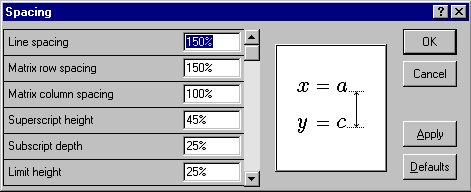Written by Allen Wyatt (last updated August 24, 2019)
This tip applies to Word 97, 2000, 2002, and 2003
When using the Equation Editor, you can control the spacing it uses between elements of your equation. You enter this spacing as an adjustment to the normal spacing between letters, which is a percentage of the regular spacing. Thus, 150% would be half again as much spacing as normally exists between elements. You set this adjustment as follows:

Figure 1. The Spacing dialog box.
WordTips is your source for cost-effective Microsoft Word training. (Microsoft Word is the most popular word processing software in the world.) This tip (943) applies to Microsoft Word 97, 2000, 2002, and 2003.

The First and Last Word on Word! Bestselling For Dummies author Dan Gookin puts his usual fun and friendly candor back to work to show you how to navigate Word 2019. Spend more time working and less time trying to figure it all out! Check out Word 2019 For Dummies today!
If you are using matrices in your equations, you may want to adjust the spacing used between columns.
Discover MoreThe Equation Editor is a great tool for designing and displaying all sorts of equations in a document. It is not very ...
Discover MoreThe Equation Editor is a tool you can use to create complex mathematical formulas and insert them in your documents. ...
Discover MoreFREE SERVICE: Get tips like this every week in WordTips, a free productivity newsletter. Enter your address and click "Subscribe."
There are currently no comments for this tip. (Be the first to leave your comment—just use the simple form above!)
Got a version of Word that uses the menu interface (Word 97, Word 2000, Word 2002, or Word 2003)? This site is for you! If you use a later version of Word, visit our WordTips site focusing on the ribbon interface.
Visit the WordTips channel on YouTube
FREE SERVICE: Get tips like this every week in WordTips, a free productivity newsletter. Enter your address and click "Subscribe."
Copyright © 2025 Sharon Parq Associates, Inc.
Comments